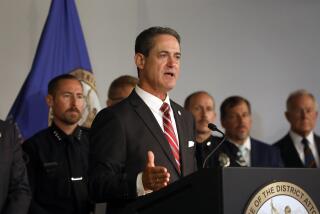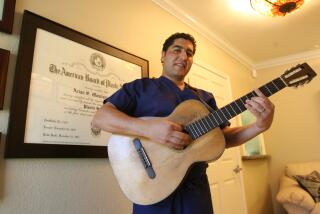Man Is Accused of Posing as Physician at Emergency Clinic
A Santa Ana man who worked at a walk-in emergency clinic for nearly 1 1/2 years, performing minor surgery and other treatment, was arrested by state investigators Monday night and accused of posing as a physician.
Enrique Herrera, 36, had been using the identity and credentials of retired Oxnard physician Alvin J. Stewart during his employment at Emergi-Care Family Center, which has offices in Fountain Valley and Westminster, said Ken Wagstaff, director of the Board of Medical Quality Assurance.
Although they have no direct evidence yet, investigators have been told that Herrera performed Pap smears, minor surgery such as suturing wounds and other medical practices associated with family care, Wagstaff said.
No Complaints From Patients
While there were no complaints from patients about their care, Wagstaff said, “it’s very serious because you don’t know what he’s not going to spot.”
Officials were alerted in March when Herrera applied for renewal of Stewart’s medical license. Officials contacted Stewart, who told them he had retired in 1982 and had not applied for renewal, board authorities said.
Investigators Jerry Smith and Lowell Jibben eventually traced the suspect to the Emergi-Care clinic in Fountain Valley and made the arrest at 5:30 p.m. Monday at Herrera’s home in the 3100 block of Salta Street, Wagstaff said.
The Emergi-Care center’s medical director, Dr. Francis Foo, told investigators he was not aware that the man he knew as Stewart was not a licensed physician, Wagstaff said. He added that it is believed that Foo never saw a medical license from Herrera.
Foo could not be reached for comment Tuesday, and the office receptionist would answer no questions about Herrera.
Herrera was born in Mexico and became a U.S. citizen in 1970, Wagstaff said.
The suspect reportedly told the arresting investigators that he was trained as a physician’s assistant, but Wagstaff said Herrera is not licensed in California as a medical doctor or physician’s assistant and has never applied for a license.
Phony DMV Card
One of the documents that helped investigators trace Herrera was a Department of Motor Vehicles identification card Herrera had obtained, using Stewart’s name and a San Diego address, Wagstaff said.
Herrera was arrested on suspicion of practicing medicine without a license, a felony. He also was arrested on one count of perjury, in connection with the DMV card, one count of forging a prescription to obtain narcotics, and 13 additional counts of forging prescriptions.
He was being held at Orange County Jail on $100,000 bail.
Steve Wilford, assistant executive director of the Board of Medical Quality Assurance, said the narcotics prescription was for a patient, not for Herrera himself, and the 13 other prescriptions were for lesser drugs.
Investigators turned up the 14 prescriptions at a local pharmacy, “and we suspect that over the period of a year and a half there were considerably more than that,” Wilford said.
Wagstaff said Herrera’s arrest is the first alleged impersonation of a physician since the widely publicized case of Gerald Barnes, who twice was arrested for practicing medicine without a license.
Barnes, a pharmacist from Chicago who had lost his license, pleaded guilty to involuntary manslaughter in 1981 in connection with the death of an Anaheim diabetic patient.
On parole, he came to officials’ attention again after applying for a physician’s job in Anaheim in 1984 and was accused of practicing medicine without a license at clinics in East Los Angeles and West Covina.
He is now free on parole and was employed as a messenger for a Beverly Hills women’s health center until it went out of business a week ago, a spokeswoman for the center said.
‘Take a Hard Look’
Wagstaff said investigators still are trying to learn more about Herrera’s activities at the clinic, how he allegedly obtained Stewart’s documents, how he was hired at the clinic in November, 1984, and what he did before that.
“We’re going to take a hard look at the evidence, and I’m sure we’ll learn something we can disseminate to employers and physicians” to help prevent impostors from being hired in the future, Wagstaff said.
However, he said, “we cannot be absolutely sure there won’t be someone like Herrera again, if someone gets a hold of the right documents and has a substantial amount of guts.”
The investigators in the Board of Medical Quality Assurance’s license fraud unit were first alerted when an “alert cashier” handling the renewal application looked through the documents “and saw things didn’t add up,” Wagstaff said.
Traced Real Dr. Stewart
Officials then checked on the status of Stewart’s license, which had expired Nov. 30, 1985, according to Wilford. When they contacted Stewart in Oxnard on March 25, he told them he had not applied for renewal and was “very shocked that somebody was using his name,” Wilford said.
Stewart, 65, could not be reached for comment. He originally was licensed in 1959 as an osteopath and switched to a medical doctor’s license in 1962 when state law allowed the change, Wilford said.
Investigators then traced the application to a residence in Anaheim, but neither Stewart nor Herrera lived there. They developed additional information and eventually found a Dr. Stewart practicing in a walk-in clinic, Wagstaff said.
Investigators went there on April 18 and asked to see the man named Stewart, but Herrera was not there, Wilford said. Foo, the medical director, was alerted and supplied investigators with documents about Herrera.
Not Required to Check
It took another 10 days to locate Herrera because he heard that investigators were looking for him, Wilford said.
Unlike hospitals, emergency medical clinics are not required by law to check the status of staff physicians’ licenses with the Board of Medical Quality Assurance, Wilford said.
Hospitals hiring a physician usually do a complete credentials check, ask for references, request to see the diploma and contact the hospital where the physician had his residency, Wilford said.
Wilford said he could not divulge how much Herrera earned at the clinic but added that the Internal Revenue Service “is interested.”
More to Read
Sign up for Essential California
The most important California stories and recommendations in your inbox every morning.
You may occasionally receive promotional content from the Los Angeles Times.










